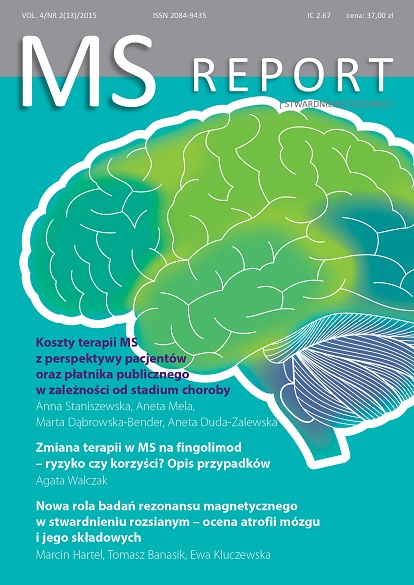A new role of magnetic resonance imaging in multiple sclerosis – atrophy assessment of the brain and its structures Review article
Main Article Content
Abstract
Not fully known pathological process in multiple sclerosis through demyelination and neurodegeneration leads to brain atrophy which is nowadays the most promising marker of patients’ status. Routine MRI reveals plaques and their evolution, however the assessment of normal appearing brain tissue remains beyond its efficiency. Volumetric techniques allow to detect differences in brain volume and its structures which correlates significantly with symptoms of patients. This article describes the potential of volumetric analysis, particularly of brain substructures.
Article Details
Issue
Section
Articles
Copyright © by Medical Education. All rights reserved.
References
1. Cohen J., Rudick R.: Multiple Sclerosis Therapeutics. Cambridge University Press, Cambridge 2011.
2. Geurts J.J., Calabrese M., Fisher E. et al.: Measurement and clinical effect of grey matter pathology in multiple sclerosis. Lancet Neurol. 2012; 11: 1082-1092.
3. Stadelmann C.: Multiple sclerosis as a neurodegenerative disease: pathology, mechanisms and therapeutic implications. Curr. Opin. Neurol. 2011; 24: 224-229.
4. Filippi M., Bozzali M., Rovaris M. et al.: Evidence for widespread axonal damage at the earliest clinical stage of multiple sclerosis. Brain 2003; 126: 433-437.
5. Simon J.H.: Brain atrophy in multiple sclerosis: what we know and would like to know. Mult. Scler. 2006; 12: 679-687.
6. Vigeveno R.M., Wiebenga O.T., Wattjes M.P. et al.: Shifting imaging targets in multiple sclerosis: from inflammation to neurodegeneration. J. Magn. Reson. Imaging. 2012; 36: 1-19.
7. Deloire M.S., Ruet A., Hamel D. et al.: MRI predictors of cognitive outcome in early multiple sclerosis. Neurology 2011; 76: 1161-1167.
8. Rocca M.A.: Deep grey matter: current and new technologies. Mult. Scler J. 2014; 20: 3-13.
9. Granberg T., Martola J., Bergendal G. et al.: Corpus callosum atrophy is associated with cognitive impairment in multiple sclerosis: results of a 17-year longitudinal study. Mult. Scler. 2014 Dec 5. pii: 1352458514560928.
10. Durand-Dubief F., Belaroussi B., Armspach J.P. et al.: Reliability of Longitudinal Brain Volume Loss Measurements between 2 Sites in Patients with Multiple Sclerosis: Comparison of 7 Quantification Techniques. AJNR Am. J. Neuroradiol. 2012; 33(10): 1918-1924.
11. Narayana P.A., Govindarajan K.A., Goel P. et al.: Regional cortical thickness in relapsing remitting multiple sclerosis: A multi-center study. NeuroImage Clin. 2012; 2: 120-131.
12. Desikan R.S., Ségonne F., Fischl B. et al.: An automated labeling system for subdividing the human cerebral cortex on MRI scans into gyral based regions of interest. NeuroImage 2006; 31(3): 968-980.
13. Fischl B., van der Kouwe A., Destrieux C. et al.: Automatically parcellating the human cerebral cortex. Cereb. Cortex. 2004; 14(1): 11-22.
14. Fischl B.: FreeSurfer. NeuroImage 2012; 62(2): 774-781.
15. Destrieux C., Fischl B., Dale A. et al.: Automatic parcellation of human cortical gyri and sulci using standard anatomical nomenclature. NeuroImage 2010; 53(1): 1-15.
2. Geurts J.J., Calabrese M., Fisher E. et al.: Measurement and clinical effect of grey matter pathology in multiple sclerosis. Lancet Neurol. 2012; 11: 1082-1092.
3. Stadelmann C.: Multiple sclerosis as a neurodegenerative disease: pathology, mechanisms and therapeutic implications. Curr. Opin. Neurol. 2011; 24: 224-229.
4. Filippi M., Bozzali M., Rovaris M. et al.: Evidence for widespread axonal damage at the earliest clinical stage of multiple sclerosis. Brain 2003; 126: 433-437.
5. Simon J.H.: Brain atrophy in multiple sclerosis: what we know and would like to know. Mult. Scler. 2006; 12: 679-687.
6. Vigeveno R.M., Wiebenga O.T., Wattjes M.P. et al.: Shifting imaging targets in multiple sclerosis: from inflammation to neurodegeneration. J. Magn. Reson. Imaging. 2012; 36: 1-19.
7. Deloire M.S., Ruet A., Hamel D. et al.: MRI predictors of cognitive outcome in early multiple sclerosis. Neurology 2011; 76: 1161-1167.
8. Rocca M.A.: Deep grey matter: current and new technologies. Mult. Scler J. 2014; 20: 3-13.
9. Granberg T., Martola J., Bergendal G. et al.: Corpus callosum atrophy is associated with cognitive impairment in multiple sclerosis: results of a 17-year longitudinal study. Mult. Scler. 2014 Dec 5. pii: 1352458514560928.
10. Durand-Dubief F., Belaroussi B., Armspach J.P. et al.: Reliability of Longitudinal Brain Volume Loss Measurements between 2 Sites in Patients with Multiple Sclerosis: Comparison of 7 Quantification Techniques. AJNR Am. J. Neuroradiol. 2012; 33(10): 1918-1924.
11. Narayana P.A., Govindarajan K.A., Goel P. et al.: Regional cortical thickness in relapsing remitting multiple sclerosis: A multi-center study. NeuroImage Clin. 2012; 2: 120-131.
12. Desikan R.S., Ségonne F., Fischl B. et al.: An automated labeling system for subdividing the human cerebral cortex on MRI scans into gyral based regions of interest. NeuroImage 2006; 31(3): 968-980.
13. Fischl B., van der Kouwe A., Destrieux C. et al.: Automatically parcellating the human cerebral cortex. Cereb. Cortex. 2004; 14(1): 11-22.
14. Fischl B.: FreeSurfer. NeuroImage 2012; 62(2): 774-781.
15. Destrieux C., Fischl B., Dale A. et al.: Automatic parcellation of human cortical gyri and sulci using standard anatomical nomenclature. NeuroImage 2010; 53(1): 1-15.

